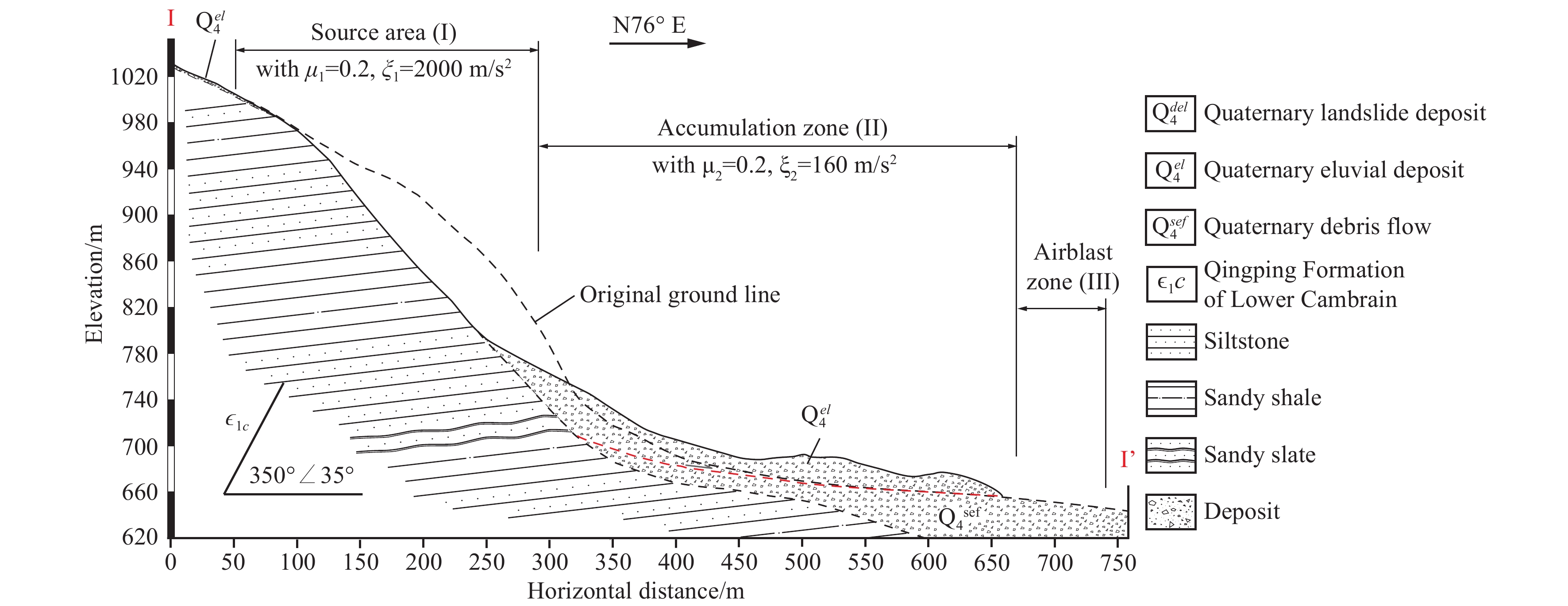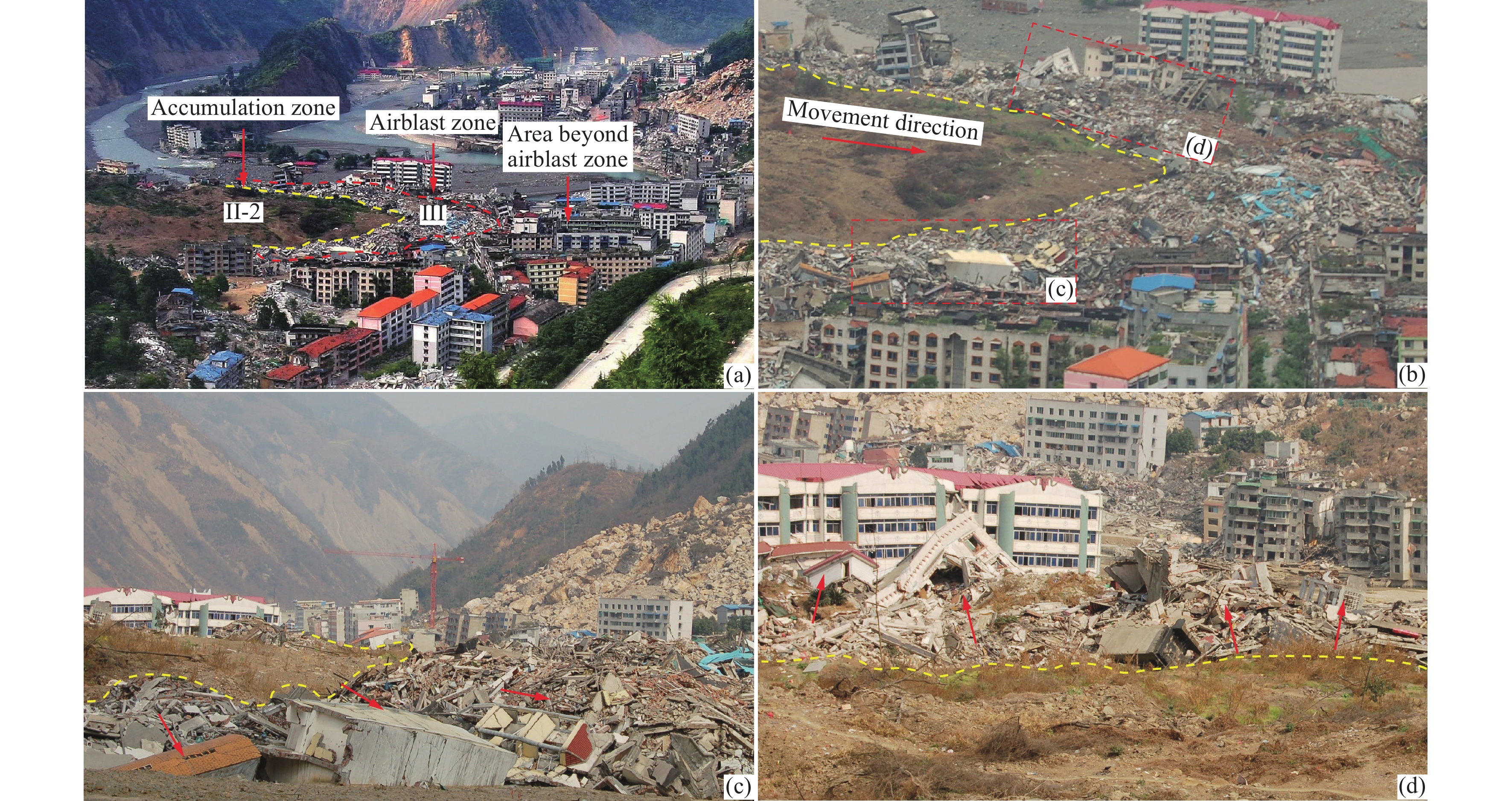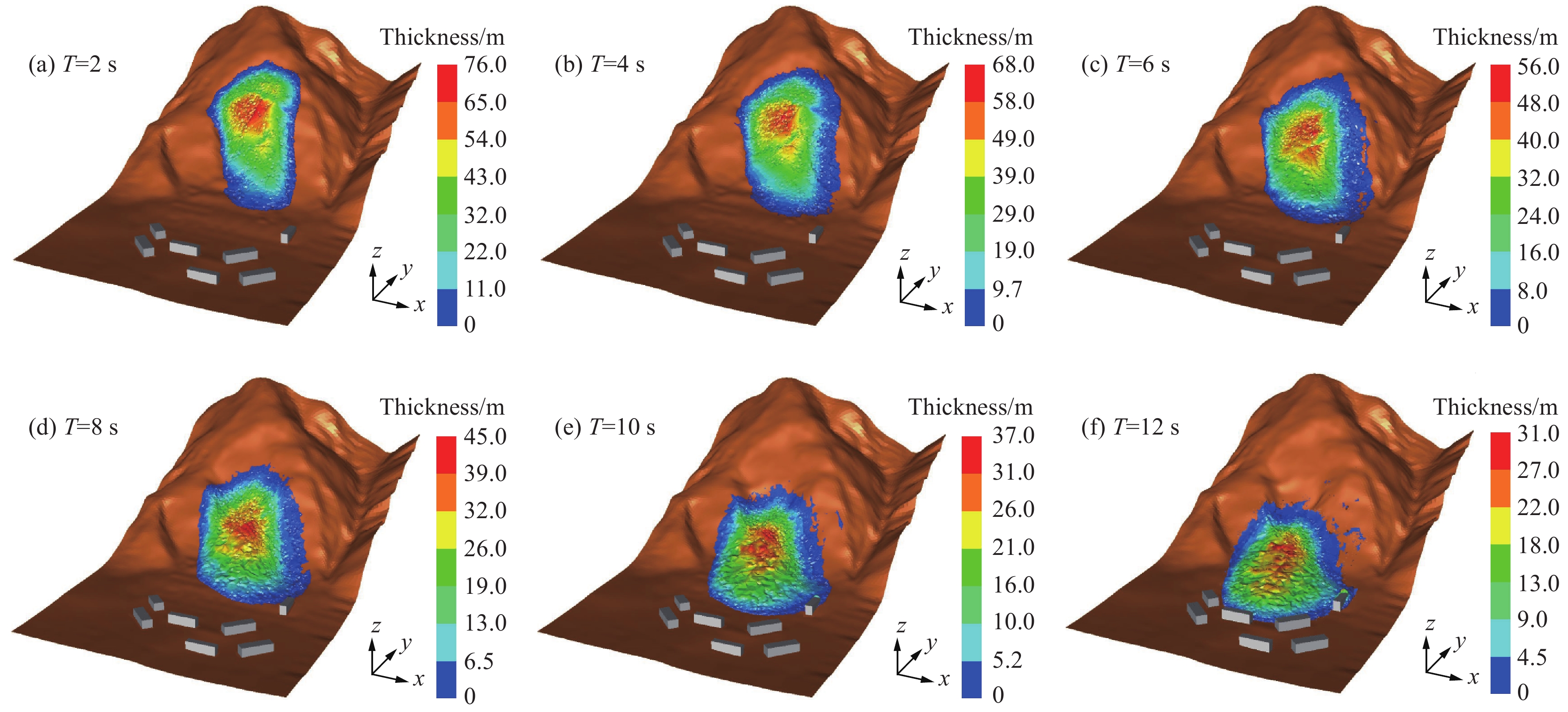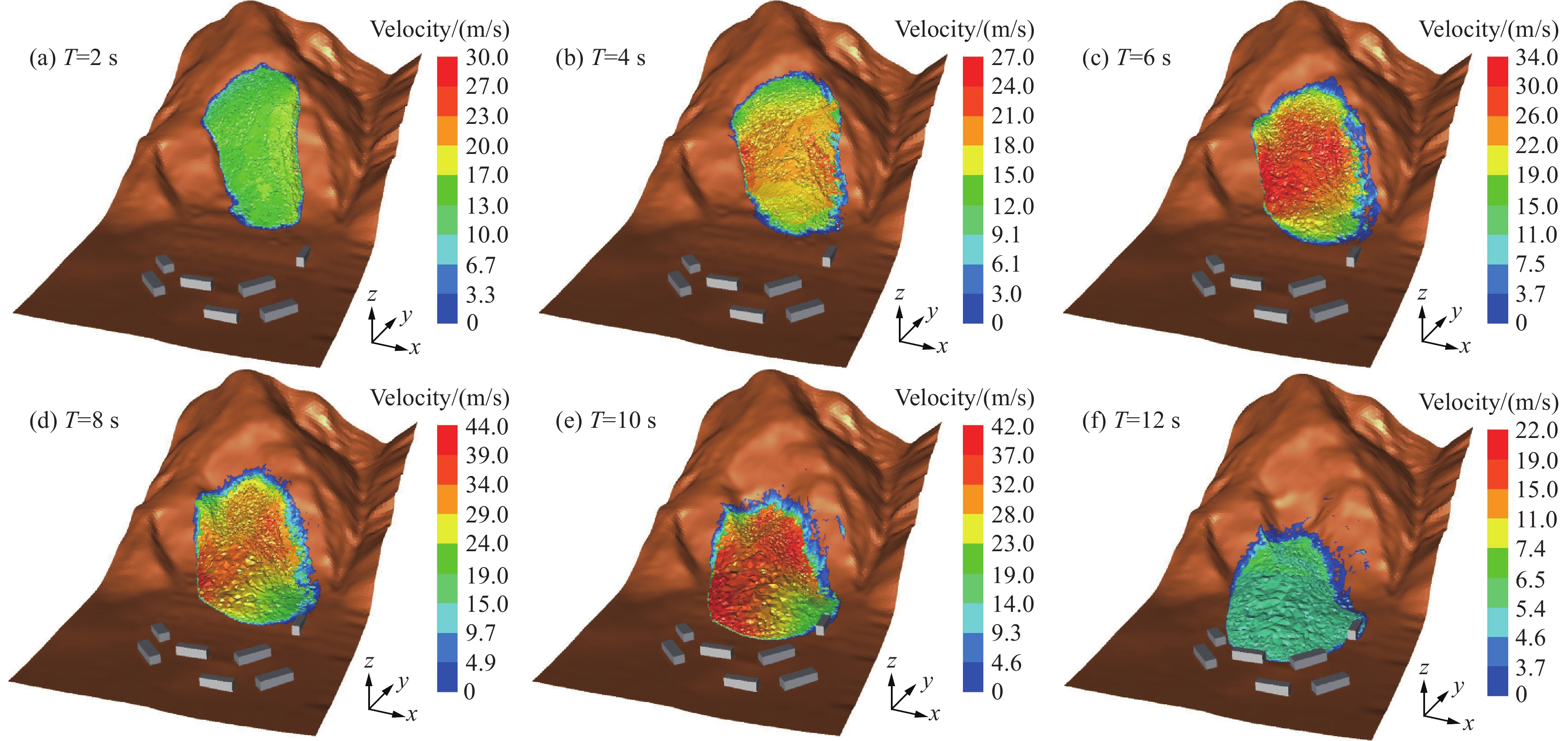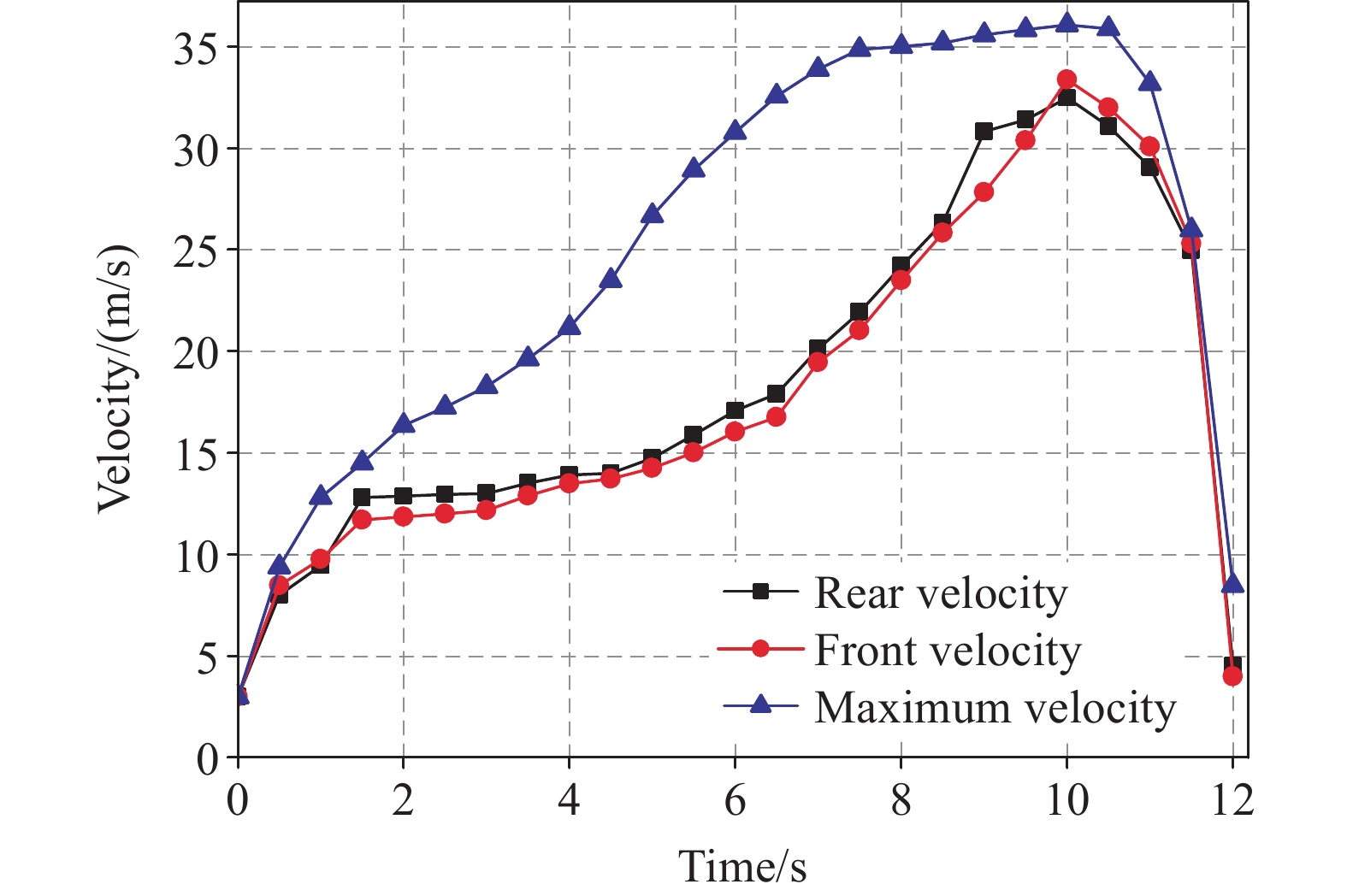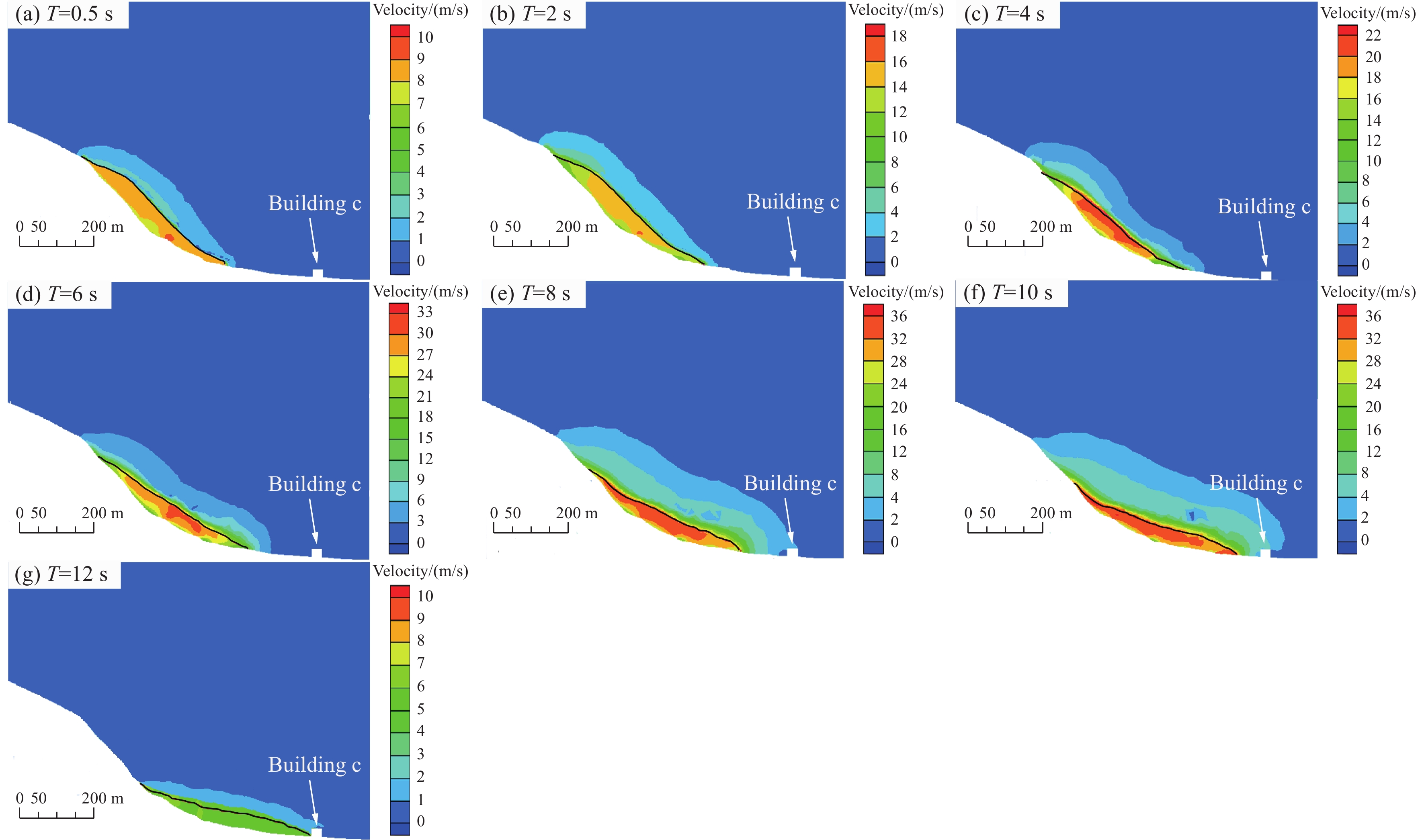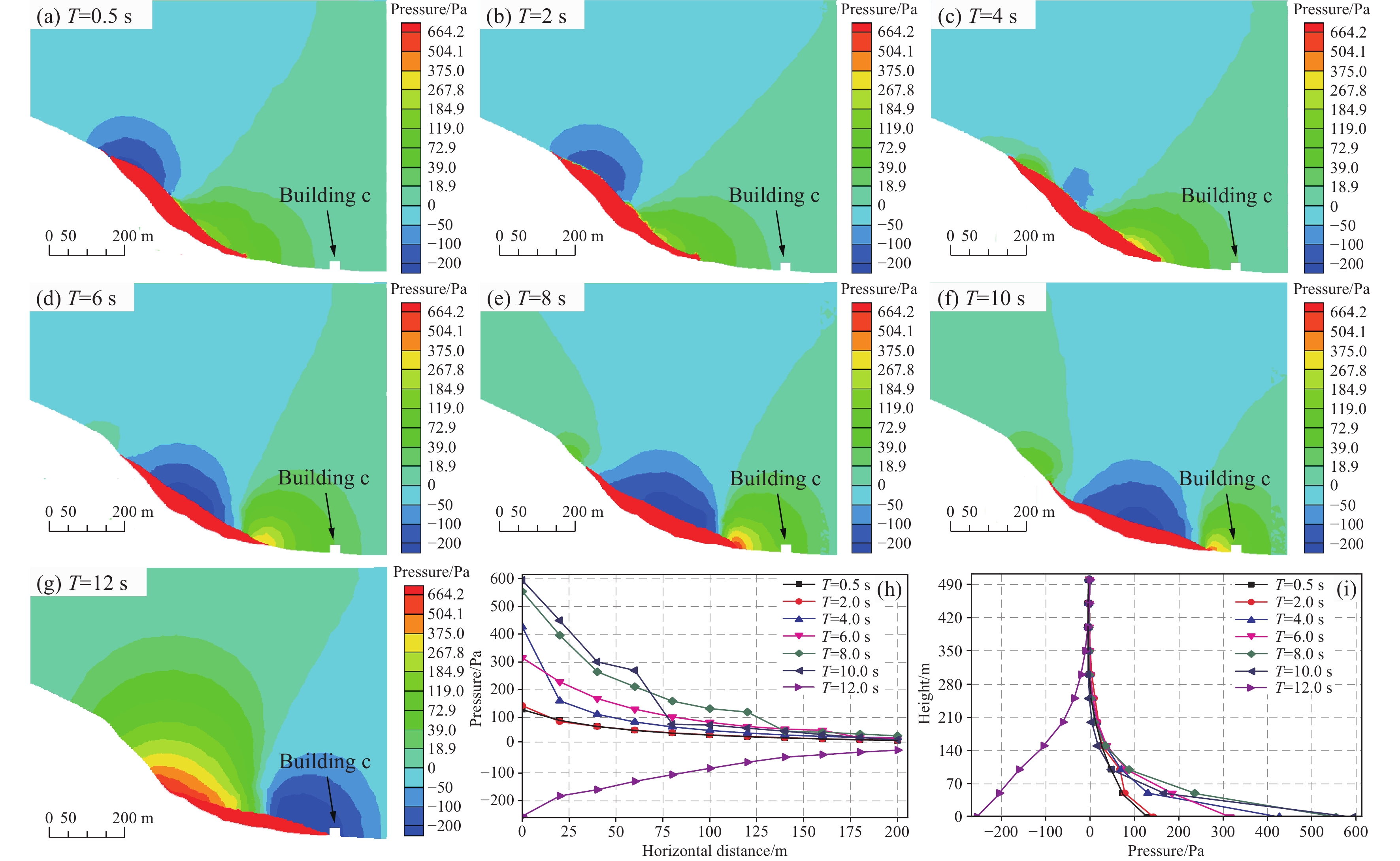| Citation: | Yu-feng Wang, Qian-gong Cheng, Qi Zhu, 2024. Airblast evolution initiated by Wangjiayan landslides in the Ms 8.0 Wenchuan earthquake and its destructive capacity analysis, China Geology, 7, 237-247. doi: 10.31035/cg2023154 |
Airblast evolution initiated by Wangjiayan landslides in the Ms 8.0 Wenchuan earthquake and its destructive capacity analysis
-
Abstract
Airblasts, as one common phenomenon accompanied by rapid movements of landslides or rock/snow avalanches, commonly result in catastrophic damages and are attracting more and more scientific attention. To quantitatively analyze the intensity of airblast initiated by landslides, the Wangjiayan landslide, occurred in the Wenchuan earthquake, is selected here with the landslide propagation and airblast evolution being studied using FLUENT by introducing the Voellmy rheological law. The results reveal that: (1) For the Wangjiayan landslide, its whole travelling duration is only 12 s with its maximum velocity reaching 36 m/s at t=10 s; (2) corresponding to the landslide propagation, the maximum velocity, 28 m/s, of the airblast initiated by the landslide also appears at t=10 s with its maximum pressure reaching 594.8 Pa, which is equivalent to violent storm; (3) under the attack of airblast, the load suffered by buildings in the airblast zone increases to 1300 Pa at t=9.4 s and sharply decreased to ‒7000 Pa as the rapid decrease of the velocity of the sliding mass at t=10 s, which is seriously unfavorable for buildings and might be the key reason for the destructive collapse of buildings in the airblast zone of the Wangjiayan landslide.
-
Keywords:
- Landslide /
- Voellmy rheological law /
- 3D FLUENT simulation /
- Airblast /
- Intensity /
- Wenchuan earthquake
-

-
References
Catane SG, Cabria HB, Zarco MAH, Saturay Jr RM, Mirasol-Robert AA. 2008. The 17 February 2006 Guinsaugon rock slide-debris avalanche, Southern Leyte, Philippines: deposit characteristics and failure mechanism. Bulletin of Engineering Geology and the Environment, 67, 305–320. doi: 10.1007/s10064-008-0120-y. Chen H, Lee CF. 2003. A dynamic model for rainfall-induced landslides on natural slopes. Geomorphology, 51(4), 269–288. doi: 10.1016/S0169-555X(02)00224-6. Cheng QG, Wang YF, Zhu Q. 2012. Airblast generated by rock avalanche. In: Landslides and Engineered Slopes: Protecting Society through Improved Understanding. London, UK, CRC Press, Taylor & Francis Group, 841‒848. Crosta GB, Chen H, Lee CF. 2004. Replay of the 1987 Val Pola Landslide, Italian Alps. Geomorphology, 60(1–2), 127–146. doi: 10.1016/j.geomorph.2003.07.015. Cruden DM, Lu ZY. 1992. The landslide and debris flow from Mount Cayley, B. C., in June 1984. Canada Geotechnical Journal, 29 (4), 614‒626. doi: 10.1139/t92-069. Cui P, Chen XQ, Zhu YY, Su FH, Wei FQ, Han YS, Liu HJ, Zhuang JQ. 2011. The Wenchuan Earthquake (May 12, 2008), Sichuan Province, China, and resulting geo-hazards. Natural Hazards, 56, 19–36. doi: 10.1007/s11069-009-9392-1. Dai FC, Xu C, Yao X, Lu L, Tu XB, Gong QM. 2011. Spatial distribution of landslides triggered by the 2008 Ms 8.0 Wenchuan earthquake, China. Journal Asian Earth Sciences, 40(4), 883‒895. doi: 10.1016/j.jseaes.2010.04.010. Delaney KB, Evans SG. 2015. The 2000 Yigong landslide (Xizang Plateau), landslide-dammed lake and outburst flood: Review, remote sensing analysis, and process modelling. Geomorphology, 246, 377–393. doi: 10.1016/j.geomorph.2015.06.020. Dreier L, Bühler Y, Ginzler C, Bartelt P. 2016. Comparison of simulated powder snow avalanches with photogrammetric measurements. Annals of Glaciology, 57(71), 371–381. doi: 10.3189/2016aog71a532. Erismann TH, Abele G. 2001. Dynamics of landslides and rockfalls. Berlin, Springer Berlin, Heidelberg, 316. Fahnestock RK. 1978. Little Tahoma Peak rockfalls and avalanches, MountRainier, Washington, U. S. A. In: Landslides and Avalanches: Vo. l 1, Natural Phenomena. US, Elsevier, 181‒196. Ginger J. 2000. Internal pressures and cladding net wind loads on full-scale low-rise building. Journal of Structure Engineering, 126(4), 538–543. doi: 10.1061/(ASCE)0733-9445(2000)126:4(538). Heim A. 1932. Bergsturz und Menschenleben. Zütich: Naturforschenden Gesellschaft. English Translation by SKERNER N A. Landslides and Human Lives. Vancouver: BiTech Publishers Ltd, 1989, 1‒195. Hungr O. 1995. A model for the runout analysis of rapid flow slides, debris flows, and avalanches. Canada Geotechnical Journal, 32(4), 610–623. doi: 10.1139/t95-063. Hungr O, Evans SG. 1996. Rock avalanche runout prediction using a dynamic model. In: Proceedings of the 7th International Symposium on Landslides. CRC Press, Taylor & Francis Group, Trondheim, NO, 233‒238. Hungr O, Evans SG. 2004. Entrainment of debris in rock avalanches; an analysis of a long run-out mechanism. GSA Bulletin, 116(9‒10), 1240‒1252. doi: 10.1130/B25362.1. Jiang Y, Zhao QH, Yan MG. 1991. Xikou mountain landslide-debris flow, China. In: Balkema AA and Rotterdam (eds.), International symposlum on landslides. Netherlands, 133‒138. Kargel JS, Leonard GJ, Shugar DH, Haritashya UK, Bevington A, Fielding EJ, Fujita K, Geertsema M, Miles ES, Steiner J, Anderson E, Bajracharya S, Bawden GW, Breashears DF, Byers A, Collins B, Dhital MR, Donnellan A, Evans TL, Geai ML, Glasscoe MT, Green D, Gurung DR, Heijenk R, Hilborn A, Hudnut K, Huyck C, Immerzeel WW, Jiang LM, Jibson R, Kääb A, Khanal NR, Kirschbaum D, Kraaijenbrink PDA, Lamsal D, Liu SY, Lv MY, Mckinney D, Nahirnick NK, Nan ZT, Ojha S, Olsenholler J, Painter TH, Pleasants M, Pratima KC, Yuan QI, Raup BH, Regmi D, Rounce DR, Sakai A, Shangguan DH, Shea JM, Shrestha AB, Shukla A, Stumm D, Van der kooij m, Voss K, Wang X, Weihs B, Wolfe D, Wu LZ, Yao XJ, Yoder MR, Young N. 2016. Geomorphic and geologic controls of geohazards induced by Nepal’s 2015 Gorkha earthquake. Science, 351 (6269). doi: 10.1126/science.aac8353. Kiersch GW. 1964. Vaiont reservoir disaster. Civil Engineering, 34, 32–39. Mathews WH, McTaggart KC. 1978. Hope landslides, British Columbia, Canada. In: Landslides and Avalanches: Vol. 1, Natural Phenomena. US, Elsevier, 259‒276. McKinnon M, Hungr O, McDougall S. 2008. Dynamic analyses of Canadian landslides. In: Proceedings of the Fourth Canadian Conference on GeoHazards: From Causes to Management. Canadian Geotechnical Society, Engineering Geology Division, Presse de l'Université de Laval, CA, 20‒24. Mehta KC. 1984. Wind induced damage observations and their implications to design practice. Engineering Structure, 6(4), 242–247. doi: 10.1016/0141-0296(84)90019-1. Morrissey MM, Savage WZ, Wieczorek GF. 1999. Air blasts generated from rockfall impacts: Analysis of the 1996 Happy Isles event in Yosemite National Park. Journal of Geophysical Research:Solid Earth, 104(B10), 23189–23198. doi: 10.1029/1999JB900189. Penna IM, Hermanns RL, Nicolet P, Morken OA, Dehls J, Gupta V, Jaboyedoff M. 2021. Airblasts caused by large slope collapses. GSA Bulletin, 133 (5‒6), 939‒948. doi: 10.1130/B35531.1. Pirulli M, Scavia C, Hungr O. 2004. Determination of rock avalanche run-out parameters through back analyses. In: Balkema AA and Rotterdam (eds. ), Proceedings of the 9th International Symposium on Landslides. London, UK, 1361‒1366. Plafker G, Ericksen GE. 1978. Nevados Huascaran avalanches, Peru. In: Landslides and Avalanches: Vol. 1, Natural Phenomena. US, Elsevier, 277‒314. Sosio R, Crosta GB, Hungr O. 2008. Complete dynamic modeling calibration for the Thurwieser rock avalanche (Italian Central Alps). Engineering Geology, 100(1‒2), 11‒26. doi: 10.1016/j.enggeo.2008.02.012. Tang HM, Jia HB, Hu XL, Li DW, Xiong CR. 2010. Characteristics of landslides induced by the great Wenchuan earthquake. Journal of Earth Science, 21, 104–113. doi: 10.1007/s12583-010-0008-1. Voight B. 1978. Lower Gros Ventre slide, Wyoming, U. S. A., In: Landslides and Avalanches: Vo. l 1, Natural Phenomena. US, Elsevier, 113‒166. Wieczorek GF, Snyder JB, Waitt RB, Morrissey MM, Uhrhammer RA, Harp EL, Norris RD, Bursik MI, Finewood LG. 2000. Unusual July 10, 1996, rock fall at Happy Isles, Yosemite National Park, California. GSA Bulletin 112(1), 75‒85. doi: 10.1130/0016-7606(2000)112<75:UJRFAH>2.0.CO;2. Xu Q, Shang YJ, Asch TV, Wang ST, Zhang ZY, Dong XJ. 2012. Observations from the large, rapid Yigong landslide-debris avalanche, southeast Xizang. Canada Geotechnical Journal, 49, 589–606. doi: 10.1139/t2012-0. Yin YP, Wang FW, Sun P. 2009. Landslide hazards triggered by the 2008 Wenchuan earthquake, Sichuan, China. Landslides, 6, 139–152. doi: 10.1007/s10346-009-0148-5. Yin YP, Zheng WM, Li XC, Sun P, Li B. 2011. Catastrophic landslides associated with the M 8. 0 Wenchuan earthquake. Bulletin of Engineering Geology and the Environment, 70, 15–32. doi: 10.1007/s10064-010-0334-7. Zhuang Y, Xu Q, Xing AG. 2019. Numerical investigation of the air blast generated by the Wenjia valley rock avalanche in Mianzhu, Sichuan, China. Landslides, 16, 2499–2508. doi: 10.1007/s10346-019-01253-0. Zhuang Y, Xu Q, Xing AG, Bilal M, Gnyawali KR. 2023a. Catastrophic air blasts triggered by large ice/rock avalanches. Landslide, 20, 53–64. doi: 10.1007/s10346-022-01967-8. Zhuang Y, Xing AG, Bartelt P, Bilal M, Ding ZW. 2023b. Dynamic response and breakage of trees subject to a landslide-induced air blast: Implications for air blasts risk assessment in mountainous regions. Natural Hazards and Earth System Sciences, 23(4), 1257–1266. doi: 10.5194/nhess-23-1257-2023. -
Access History

-
Figure 1.
Location map of the Wangjiayan landslide (a) with the photos of its pre- (b) and post-sliding (c).
-
Figure 2.
Longitudinal profile I–I’ of the Wangjiayan landslide with the location of I–I’ marked in Fig. 1c.
-
Figure 3.
Photos of the preserved stratigraphy in subzone II‒2.
-
Figure 4.
Photos show the display of buildings around the Wangjiayan landslide (a) with enlarged views to show the deposited features of the collapsed buildings in the airblast zone (b‒d).
-
Figure 5.
3D numerical model of the studied area (a) with the arrangements of the monitoring points on the windward surfaces of the buildings a, c, e, g (b) and b, d, f (c).
-
Figure 6.
Snapshots exhibit the geomorphologic and debris thickness evolutions of the sliding mass.
-
Figure 7.
Snapshots exhibit the velocity variation of the sliding mass.
-
Figure 8.
Time histories of the maximum, front and rear velocities of the sliding mass.
-
Figure 9.
Snapshots exhibit the velocity variation of airblast.
-
Figure 10.
Snapshots exhibit the airblast pressure variation (a‒g) with the horizontal (h) and vertical (i) variations of the airblast pressure ahead of the sliding mass versus time being graphed.
-
Figure 11.
Pressure evolutions loaded on the monitored points of the buildings c (a) and f (b).



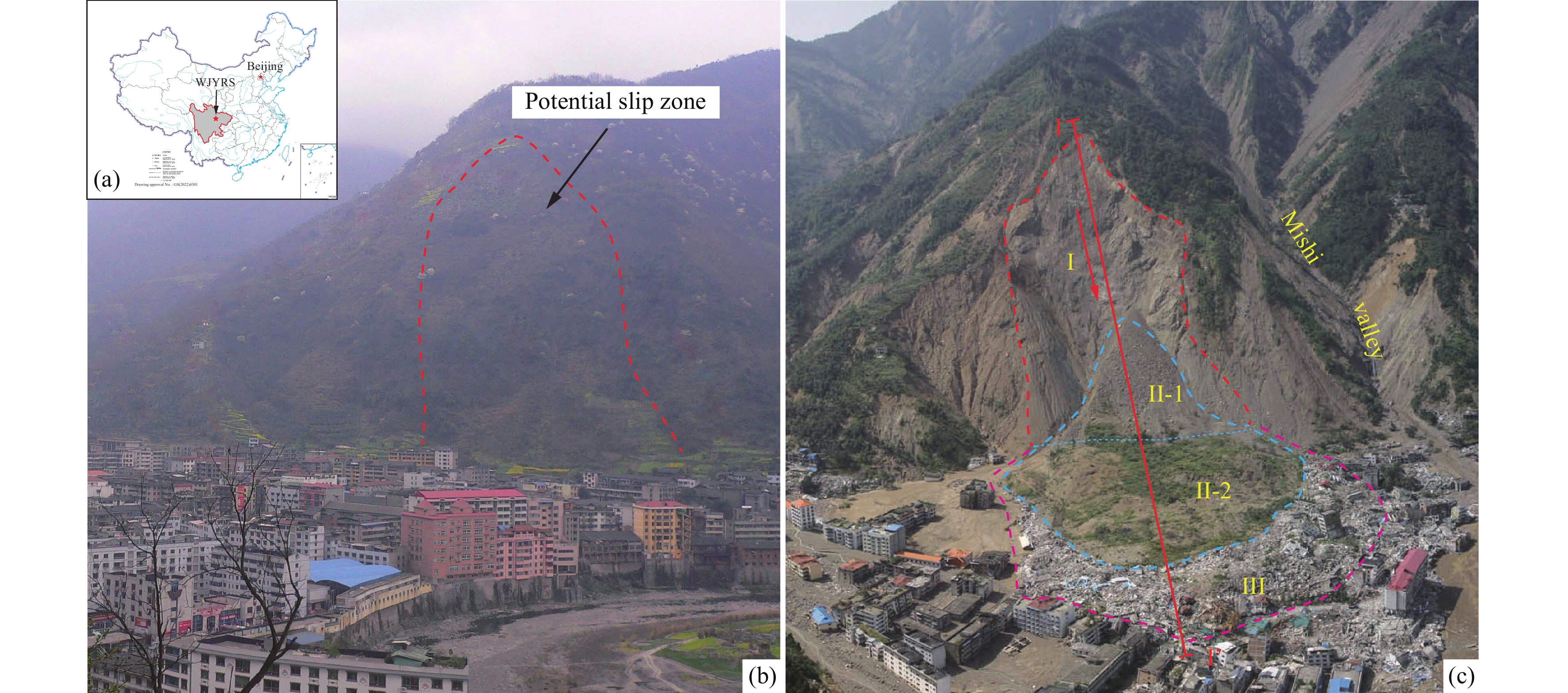

 DownLoad:
DownLoad:
